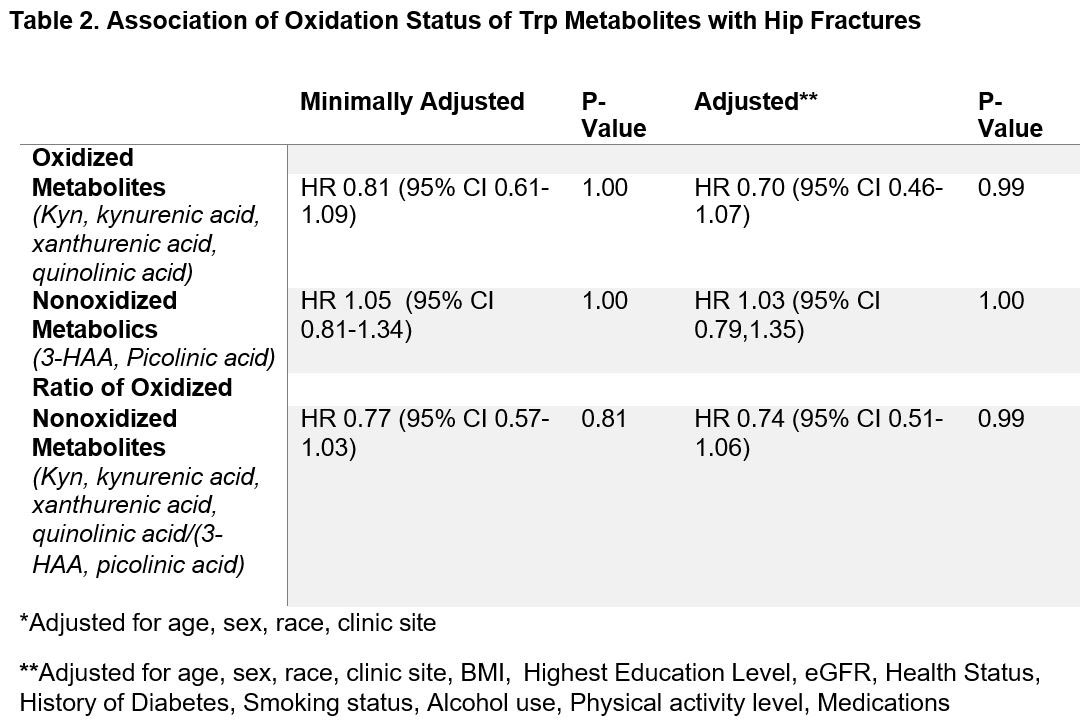Session Information
Date: Sunday, November 13, 2022
Title: Osteoporosis and Metabolic Bone Disease – Basic and Clinical Science Poster
Session Type: Poster Session C
Session Time: 1:00PM-3:00PM
Background/Purpose: Essential amino acids including tryptophan (trp) are building blocks for protein, and adequate protein intake is important for skeletal homeostasis. In experimental studies, trp increases bone formation. However, particularly with aging, trp is susceptible to oxidative modification, and oxidative stress is associated with osteoporosis. We sought to determine whether serum levels of trp and its oxidized and nonoxidized metabolites were risk factors for hip fracture and frailty.
Methods: We included participants within the Cardiovascular Health Study (CHS), a longitudinal study of community-dwelling adults aged 65 years and older from four U.S. sites. We selected participants from years 1992-1993 (year five of CHS) for whom stored serum was available and for whom there was complete information on relevant covariates. We included 131 individuals who sustained a hip fracture during the following twelve years of follow-up and 131 participants without an incident hip fracture over these following twelve years of follow- up (controls). Individuals were weighted by sex, race and hip fracture status to represent the whole CHS population at year 5. Measurements of trp and its metabolites were performed using liquid chromatograph-mass spectrometry analyses. Cox hazard models with robust standard errors were used to estimate the association of trp and its metabolites with hip fractures censoring at the first hip fracture event, death, loss of follow up or after 12 years of follow-up. Relative risk regression was done to evaluate the cross sectional association of trp and its metabolites with frailty using Freid’s index with categories defined as frail vs. not frail and prefrail vs. frail. False discovery rate approach was used to adjust p values for multiple testing for secondary exposures. The primary exposure was trp; trp metabolites were secondary exposures.
Results: Higher serum levels of trp were significantly inversely associated with risk of incident hip fractures (Table 1) There were no statistically significant associations between the oxidized or nonoxidized products of trp with incident hip fractures (Tables 1 and 2) or with frailty status (frail vs. not frail) or with prefrail vs. not frail status (p >0.05 for both).
Conclusion: Trp, but not its metabolites, was significantly associated with less risk for incident hip fractures in older adults. Neither trp nor any of its metabolites was significantly associated with frailty. Prospective cohort studies are needed to estimate what difference in trp intake is associated with an absolute difference in incident hip fractures to design a future randomized clinical trial.
To cite this abstract in AMA style:
Carbone L, Bůžková P, Robbins J, Fink H, Barzilay J, Elam R, Isales C. The Role of Tryptophan and Its Metabolites in Risk for Incident Hip Fractures and Frailty: The Cardiovascular Health Study [abstract]. Arthritis Rheumatol. 2022; 74 (suppl 9). https://acrabstracts.org/abstract/the-role-of-tryptophan-and-its-metabolites-in-risk-for-incident-hip-fractures-and-frailty-the-cardiovascular-health-study/. Accessed .« Back to ACR Convergence 2022
ACR Meeting Abstracts - https://acrabstracts.org/abstract/the-role-of-tryptophan-and-its-metabolites-in-risk-for-incident-hip-fractures-and-frailty-the-cardiovascular-health-study/


